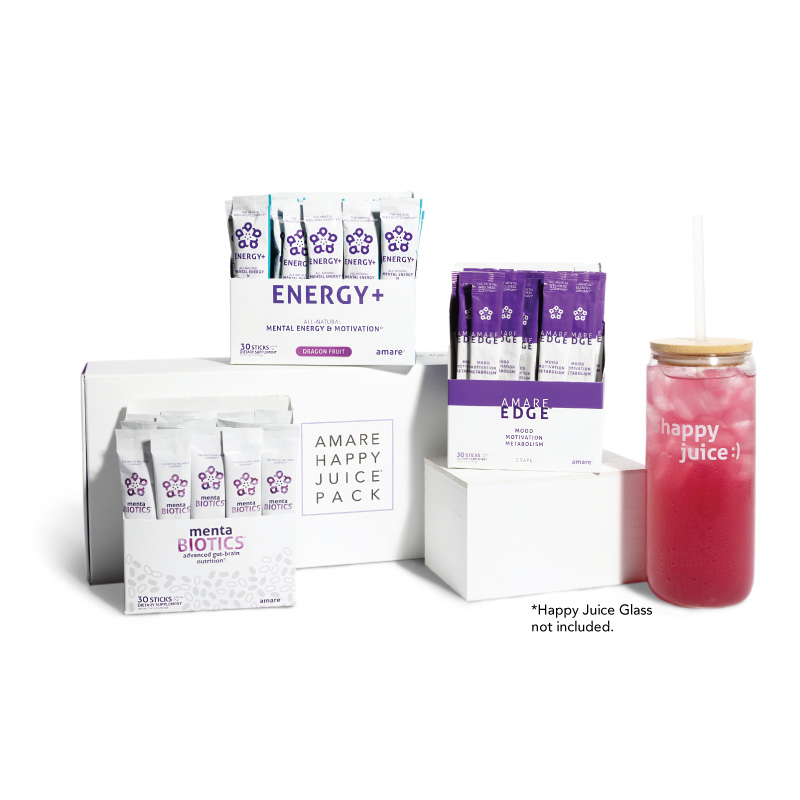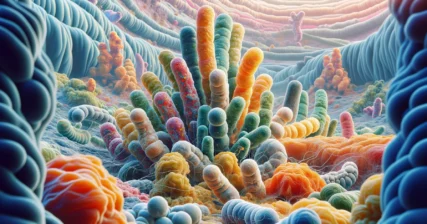Listen on: Apple Podcasts | Spotify
Glutathione is often referred to as “the body’s master antioxidant.” But that description doesn’t do justice to the health benefits of glutathione and how it affects your wellbeing and longevity.
In this article, I’ll address the following. To jump to a specific section, click on the link.

Feel Better Fast. Guaranteed.
Energy+, EDGE, and MentaBiotics make up the Happy Juice supplement stack, with ingredients clinically proven to:
- decrease anxiousness scores by 55%
- decrease irritability scores by 60%
- decrease fatigue by 64%
- decrease anger 54%
- decrease tension by 45%
- decrease confusion by 43%
- decrease overall distress by 49%
- increase good bacteria by 70%
- decrease negative mood by 105%
- increase positive mood by 211%
What Is Glutathione?
Glutathione is tripeptide made from the amino acids cysteine, glycine, and glutamic acid. A tripeptide is a compound made with three amino acids.
Peptides and proteins are similar in that they’re both made of amino acids. However, proteins are much, much larger. It’s like the difference between our grandson’s half-ounce Tonka Tiny dump truck, and a 700,000 pound Caterpillar dump truck.
All three amino acids – cysteine, glycine, and glutamic acid – are necessary to build glutathione. But cysteine is the rate-limiting amino acid, meaning that if you’re supply of cysteine is low, your glutathione levels will fall.
Glutathione is found in two forms in the body: reduced (GSH) and oxidized (GSSG). Oxidized glutathione is made from two reduced GSHs bonded together by sulfur atoms. Not surprisingly, this makes sulfur another key component of glutathione function.
Sulfur is the third-most abundant mineral in the body. If you recall from Do Detox Diets Work, sulfur plays a critical role in detoxification. No sulfur, no GSSG.
Healthy cells contain about 100 times as much GSH as GSSG. However, under significant oxidative stress, the ratio of GSH:GSSG can drop from 100:1 to 10:1 or even 1:1.
What Does Glutathione Do?
Glutathione plays a number of important roles in maintaining health, many of which are still being discovered.
Detoxification
Glutathione protects the body from heavy metals, and toxins like alcohol and persistent organic pollutants.
It also helps transport mercury out of cells and out of the brain. If you have mercury-filled fillings, which can leach mercury into your body, you will use glutathione as part of Phase I detoxification to remove it.
Though glutathione can help remove many of these toxins, if your demand for glutathione exceeds supply, you may not have enough for other roles it plays in the body.
Combats Free Radicals
Glutathione acts as a powerful antioxidant. It also helps regenerate the antioxidants vitamins C and E.
In fact, lower GSH levels are thought to be one of the main causes of the acceleration of degenerative diseases. When glutathione isn’t available to squelch free radicals, free radicals spread faster and inflict greater damage.
I think of it like a California wildfire. As long as there’s enough nearby water and other stuff to stop a fire, you can end the blaze it before it does much damage. But, if all the water was being used to water homes in Las Vegas, there won’t be enough flowing to California to stop the blaze.
In your body, if you need to squelch the free radicals caused by your elevated blood sugar, but you’re using up most of your glutathione to deal with heavy metals you’re unknowingly consuming in your “greens drink,” three scenarios could play out.
- You handle the heavy metals, but don’t deal with the free radicals caused by your high blood sugar
- You deal with the free radicals from the high blood sugar, but don’t handle the heavy metals
- You do a mediocre job at handling both, and they both cause long-term damage
By the way, I’m trying to simplify this as much as possible so you understand the concept, rather than leave your bored by writing about “the reduction of disulfides, hydroperoxides, sulfenic acids, and nitrosothiols, the detoxification of aldehydes, xenobiotics, and heavy metals, and the synthesis of eicosanoids, steroids, and iron–sulfur clusters.” (Deponte M)
Enhances Skin Health
As an antioxidant, glutathione protects the skin from the damage of ultraviolet light. Maintaining higher glutathione levels may slow the development of wrinkles and improve skin elasticity.
GSH may also reduce hyperpigmentation, like melasma.
Multiple studies have shown that supplementing with 250-500 mg per day of glutathione has a skin-lightening effect. The exact cause isn’t known, but it seems that glutathione inhibits tyrosinase.
Supports Fertility
High levels of oxidative stress, or uncontrolled free radical production, interfere with fertility in both men and women.
In men, glutathione deficiency reduces sperm motility. In women, glutathione protects the egg from free radicals. Low levels can lead to premature aging of the ovary. Low levels also occur in ovarian cancer.
At a dose of 600 mg every other day, glutathione supplementation was shown to support sperm quality and motility. The benefits disappeared immediately after use was discontinued.
Slows Premature Aging
Free radical damage is one of the most significant causes of aging in general. Excessive free radical damage can lead to accelerated aging, even of younger adults.
Low GSH levels lead to higher rates of oxidative stress, so in this way, maintaining normal levels of glutathione can help avoid aging faster than necessary.
What causes low glutathione?
Glutathione levels fall for four main reasons, though other factors contribute as well.
Toxic Load
As I mentioned earlier, your body is capable of dealing with some toxins. In excess, though, you’ll use up your stores of GSH.
Heavy metals, air and water pollution, medications, excess alcohol, and even the chemicals used in personal care products and household cleaners add to the toxins you’re exposed to every day.
There’s no way to tell how much is too much until the damage has been done. Fortunately, more chemical-free personal care and household products are available today than ever before. You just have to change your buying habits.
Without question, excessive alcohol consumption causes GSH deficiency as well.
Aging
Like most other functions in the body, other than the growth of nose and ear hair, aging slows the production of glutathione.
Older adults produce less glutathione because they become less efficient at building the tripeptide. Older adults could be best served by glutathione supplementation for this reason.
Low levels of GSH are connected to an increased risk of diabetes, arthritis, cardiovascular disease, and cancer.
Low levels of GSH, or a reduced ratio of GSH:GSSG is seen in those with chronic exposure to chemical toxins, heavy metals, or alcohol. Those with macular degeneration, Parkinson’s and other neurodegenerative diseases also have low GSH.
Disease
Low glutathione levels are connected to numerous diseases. It’s unclear whether low GSH leads to faster development of disease, or if the disease causes low glutathione levels. More than likely, it’s a cycle.
Low levels lead to the disease developing faster. GSH gets used up faster as the body tries to combat the disease, which causes levels to fall even further.
Low levels occur in:
- Macular degeneration
- Parkinson’s disease
- Alzheimer’s disease
- Huntington’s disease
- COPD
- Asthma
- Autoimmune diseases
- Hypertension
- Myocardial infarction
- Cataracts
- Hearing loss
- Glaucoma
- Liver disease
- Cystic fibrosis
Nutrient Deficiencies
Nutrient deficiencies leave you without the building blocks of GSH. If you follow a higher-protein diet, you’ll consume enough of the amino acids for glutathione production. Unfortunately, most people don’t get enough protein.
Low sulfur and selenium intake also compromise GSH production. However, any other micronutrient deficiencies could indirectly lead to low GSH, as they could compromise normal, healthy metabolic function or leave you with lower than needed levels of other antioxidants like vitamins C and E.
How To Increase Glutathione
You can do a lot to support optimal glutathione levels, on top of supplementing your diet.
Reduce toxic load
Obviously, you use up glutathione when you’re detoxifying. If you reduce the amount of chemicals you need to remove from your body, you free up your glutathione levels for other activities, or ensure you have enough to remove the compounds you cannot avoid.
Exercise
Exercise significantly increases production of free radicals. That might sound like a bad thing, but it’s inevitable, as a result of energy production.
Just as your muscle grows in response to the stress of increasingly heavy loads, you produce higher levels of glutathione in response to the free radicals produced during exercise.
Of course, you can overdo it with chronic cardio or endurance training.
Read also: 7 Mind and Body Benefits of Building Muscle.
Sleep
From my experience, sleep is the easiest way to sabotage any system in the body, glutathione included.
Sleep debt leads to inflammation and other oxidative stress, which can lower GSH levels.
The effects of sleep debt are severe. If you want to support GSH production, you must get at least seven hours of sleep each night.
Eat Glutathione-Rich Foods
| Foods High In Glutathione | |
| Mushrooms | Tomatoes |
| Avocados | Oranges |
| Walnuts | Asparagus |
| Whey Protein | |
Though certain foods do contain glutathione, the amounts are often much lower than the amounts used in supplement studies. That doesn’t mean they’re not worth eating. It’s just that they sometimes get hyped up as “the best ways to boost glutathione,” and that’s rarely the case with food.
Mushrooms are a popular source of GSH. Maitake mushrooms have the highest concentration of glutathione of all mushrooms, with a concentration of 2.41 mg per gram dry weight.
Based on those findings, an ounce of dried Maitake mushrooms would have about 68 mg of glutathione.
Poppini, Pom Pom, Yellow Oyster, and Porcini mushrooms have about two-thirds of the concentration of Maitake.
Of all of the foods mentioned above, whey protein seems to boost glutathione the best.
For example, cancer patients who supplemented with 40 grams of whey protein isolate per day, along with zinc and selenium saw an 11.7% increase in glutathione levels, compared with the control group who’s levels increased by 6% over the 12-week study.
Though whey protein does contain glutathione, it’s likely that the high concentration of essential amino acids in whey also affect GSH production, which is why it’s so powerful.
Eat Sulfur-Rich Foods
As you may recall from above, sulfur is essential for the conversion of GSH to GSSG. Without sulfur, glutathione can’t do its job.
Two amino acids contain sulfur: cysteine and methionine. Not surprisingly, animal protein such as beef, fish, and poultry, is the best source.
That said, cruciferous and allium vegetables have also been shown to boost glutathione. Add some of the following to your shopping list:
- Broccoli
- Brussels sprouts
- Cauliflower
- Kale
- Garlic
- Mustard greens
- Onion
- Shallots
- Watercress
Glutathione Supplementation
When you consume glutathione as a supplement or in food, it must be broken down to its individual amino acids, and then rebuilt once the amino acids are transported from your digestive system, to you blood, to the cells that need it, and then into the cells.
Early research on animals supplemented with glutathione was promising. Supplementation increased GSH levels in those animals.
However, when humans were given glutathione, the results were disappointing. It turns out that humans have a higher concentration of the enzyme glutamyltranspeptidase (GGT), which breaks glutathione down to its respective amino acids.
In the studies that show dietary glutathione raises GSH levels, it’s likely because the amino acids are used to rebuild GSH once it makes its way into circulation.
After the disappointing results with supplements, manufacturers sought new ways to produce glutathione, hoping to bypass the digestive system.
Two newer forms do that:
- Sublingual glutathione
- Liposomal glutathione
Sublingual Glutathione
You hold the sublingual version under your tongue until it dissolves.
Sublingual glutathione bypasses the digestive system by getting absorbed through your blood vessels under your tongue.
Research suggests it raises GSH. Interestingly, since it also helps recycle other antioxidants, vitamin E levels rise with supplementation as well.
Liposomal Glutathione
The liposomal version wraps glutathione in a fatty bubble. Fatty acids can be easily transported from the digestive system into circulation.
In a recent study, liposomal GSH was supplemented in adults at doses of 500 mg and 1000 mg per day for four weeks. Their blood levels of GSH rose 40%. The rise in both groups was the same, which suggests 500 mg is sufficient as a daily dose.
Glutathione as a supplement is produced from trull yeast (Candida utilis). However, please don’t misunderstand what that means. In the confused world of nutrition, some people hear that a micronutrient is made by yeast, and believe they shouldn’t use it because they have a problem with yeast.
That would be like saying you can’t use vitamin D because you’re allergic to sheep, and vitamin D3 comes from sheep’s wool. Pure glutathione is glutathione. It doesn’t matter that it was made by yeast. The yeast don’t ride along with the glutathione they produced.
Glutathione vs N-Acetylcysteine Supplementation
N-acetylcysteine (NAC) is a precursor of glutathione, meaning you need NAC in order to make glutathione.
NAC is converted to cysteine in the liver, and then cysteine, glycine, and glutamic acid are combined to form glutathione.
If you’re generally healthy, and young, you could simply take NAC to support glutathione production.
Unfortunately, with age or disease, you lose your ability to make glutathione. Also, if you have liver dysfunction, you might not be able to convert NAC to cysteine, preventing you from building glutathione.
So, even if you took NAC, you wouldn’t be able to do much with it. In these cases, the only way to raise glutathione would be to get glutathione into your system.
If you’re healthy, you could save money and use NAC. If you’re older or unhealthy, liposomal or sublingual glutathione may be necessary.
Summary
To summarize, glutathione is one of the most important compounds in the body for supporting health. Ideally you should be able to produce enough on your own, and through eating a healthy, high-protein diet and making good lifestyle choices.
Exposure to oxidative stress, toxins, high-volume endurance training, disease, and aging can all lead to low GSH levels. In these cases, using a high-quality liposomal or sublingual glutathione supplement makes a lot of sense.

Feel Better Fast. Guaranteed.
Energy+, EDGE, and MentaBiotics make up the Happy Juice supplement stack, with ingredients clinically proven to:
- decrease anxiousness scores by 55%
- decrease irritability scores by 60%
- decrease fatigue by 64%
- decrease anger 54%
- decrease tension by 45%
- decrease confusion by 43%
- decrease overall distress by 49%
- increase good bacteria by 70%
- decrease negative mood by 105%
- increase positive mood by 211%
References
Arjinpathana N, Asawanonda P. Glutathione as an oral whitening agent: a randomized, double-blind, placebo-controlled study. J Dermatolog Treat. 2012;23(2):97–102.
Bahadoran Z, Mirmiran P, Hosseinpanah F, et al. Broccoli sprouts reduce oxidative stress in type 2 diabetes: a randomized double-blind clinical trial. Eur J Clin Nutr. 2011;65(8):972-977.
Bogaards JJ, Verhagen H, Willems MI, et al. Consumption of Brussels sprouts results in elevated alpha-class glutathione S-transferase levels in human blood plasma. Carcinogenesis. 1994;15(5):1073-1075.
Bumrungpert A, Pavadhgul P, Nunthanawanich P, et al. Whey Protein Supplementation Improves Nutritional Status, Glutathione Levels, and Immune Function in Cancer Patients: A Randomized, Double-Blind Controlled Trial. J Med Food. 2018;21(6):612-616.
Campolo J, Bernardi S, Cozzi L, et al. Medium-chain effect of sublingual L-glutathione supplementation on flow-mediated dilation in subjects with cardiovascular risk factors. Nutrition. 2017;38:41-47.
Deponte M. The Incomplete Glutathione Puzzle: Just Guessing at Numbers and Figures? Antioxid Redox Signal. 2017;27(15)1130-1161.
Halpner AD, Handelman GJ, Harris JM, et al. Protection by vitamin C of loss of vitamin E in cultured rat hepatocytes. Arch Biochem Biophys. 1998;359:305-309.
Handog EB, Datuin MS, Singzon IA. An open-label, single-arm trial of the safety and efficacy of a novel preparation of glutathione as a skin-lightening agent in Filipino women. Int J Dermatol. 2016;55(2):153–157.
Kalaras MD, Richie JP, Calcagnotto A, Beelman RB. Mushrooms: A rich source of the antioxidants ergothioneine and glutathione. Food Chem. 2017;233:429-433.
Li X, Qu ZC, May JM. GSH is required to recycle ascorbic acid in cultured liver cell lines. Antioxid Redox Signal. 2001;3:1089-1097.
Montecinos V, Guzmán P, Barra V, et al. Vitamin C is an essential antioxidant that enhances survival of oxidatively stressed human vascular endothelial cells in the presence of a vast molar excess of glutathione. J Biol Chem. 2007;282:15506-15515.
Moore LE, Brennan P, Karami S, et al. Glutathione S-transferase polymorphisms, cruciferous vegetable intake and cancer risk in Central and Eastern European Cancer Study. Carcinogenesis. 2007;28(9):1960-1964.
Nuttall SL, Martin U, Sinclair AJ, Kendall MJ. Glutathione: In sickness and in health. The Lancet. 1998; 351:645-646/
Park EY, Shimura N, Konishi T, et al. Increase in the protein-bound form of glutathione in human blood after the oral administration of glutathione. J Agric Food Chem. 2014;62(26):6183–6189.
Schmitt B, Vicenzi M, Garrel C, Denis FM. Effects of N-acetylcysteine, oral glutathione (GSH) and a novel sublingual form of GSH on oxidative stress markers: A comparative crossover study. Redox Biol. 2015;6:198-205.
Sinha R, Sinha I, Calcagnotto A, et al. Oral supplementation with liposomal glutathione elevates body stores of glutathione and markers of immune function. Eur J Clin Nutr. 2018;72(1):105-111.
Townsend DM, Tew KD, Tapiero H. The importance of glutathione in human disease. Biomed Pharmaco. 2003;57(3):145-155.
Watanabe F, Hashizume E, Chan GP, Kamimura A. Skin-whitening and skin-condition-improving effects of topical oxidized glutathione: a double-blind and placebo-controlled clinical trial in healthy women. Clin Cosmet Investig Dermatol. 2014;7:267–274.
Yao DF, Mills JN. Male infertility: lifestyle factors and holistic, complementary, and alternative therapies. Asian J Androl. 2016;18(3):410-418.
Zitka O, Skalickova S, Gumulec J, et al. Redox status expressed as GSH:GSSG ratio as a marker for oxidative stress in paediatric tumour patients. Oncol. Lett. 2012;4(6):1247-1253.



